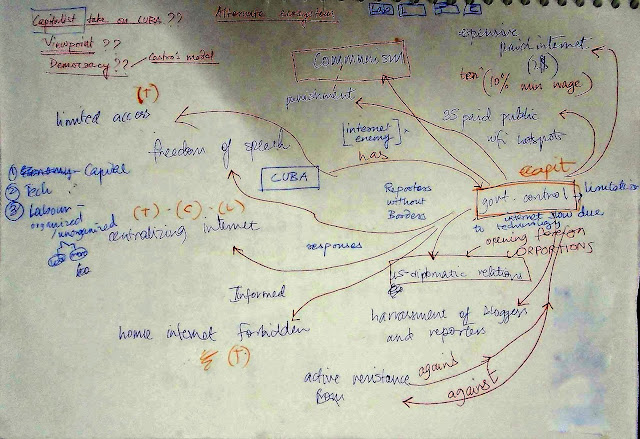Topic: Internet art(Censorship as an entry point to understand internet ecosystems).
Idea: Dealing with a
contemporary subject;talked about art net.art movement; started from
1980's and 1994; talks about Shilpa Gupta who has used internet art
as her art medium in 2003; talks about concept art related to craft;
concept of on and off.
Feedback: Search about
“Self referenciality of art” (how art history is internally
generated);
Also search about internet
art in different countries like Phillipines, Mexico, South Africa,
Argentina , Brazil, China; etc.
Process:
During
this curatorial workshop, this team started with the initial goal of
having to work around the dissertation topic to produce a curation,
which loosely discussed and contextualized the framework of
understanding internet art. However, due to the vast scope of such a
topic, they struggled to actually pin down an actual topic which
could yield a respectable display.
However,
it was soon realized within the early days of the workshop itself
that attempting to create a curation without any specialized research
and examination was a stressful, and ultimately, futile effort. They
thus learnt that the core of any specialized research for a curation
would involve a thorough understanding of the subject, as well the
intertextuality of the dynamics of various sub-topics within its
scope.
In
this case, they had to stop thinking about the aims of the
dissertation, and instead find a new trajectory of thought. They
took to explaining the meaning and context of the dissertation to the
team members, which created a lively back and forth discussion.
However,
during attempting to access the websites for internet art
practitioners via the MS University’s campus wireless internet
connection, they were flabbergasted to find the sites blocked. This
institutional blockade of seemingly innocuous content, especially
educational content seemed highly arbitrary and repressive. Many
other websites that they attempted to reach, such as vimeo.com,
adityanmekelam.com (another artist site) and shaadi.com were also
blocked from our network.
However,
they then decided to turn their lemons into lemonade by then
deciding to explore and research this very phenomenon as what it was:
CENSORSHIP
They
approached this from the somewhat belligerent attitude of students
chafing from the sting of seemingly overly-strict institutional rules
throttling the flow of our content, and were inclined to thus believe
that freedom of access to information and activity on the internet
was necessary to each and every student. Censorship of the internet,
they reasoned, was a repressive measure that seemed to distrust the
user of the network by default. They also felt that the blocking of
all these sites indicated to violate our right of freedom to
unfiltered access.
To
understand the reason behind these draconian laws, their research of
various countries yielded several mindmaps and heated discussion.
They made mindmaps of different countries, from India to Cuba to
Saudi Arabia. They marveled at the dynamic intertextuality of
pre-existing social culture and its interaction with internet, and
how each country by way of censorship and its own social norms,
created unique internet spaces for its users.
Armed
with all their knowledge, they then went to visit the most accessible
face of censorship to them : A senior-level systems analyst at the
university Computer Centre.
they
met with a highly patient, and accommodative systems analyst – who
asked to remain anonymous – who patiently explained the technical
details behind the system, the capacity of the system, and the
problems concerning information flow across the spectrum. In short,
this man provided them detailed knowledge to a vast body of
information, and answered even the loaded questions with adroit
skill: acknowledging the obvious censorship, giving practical
explanations for the stringency of the filtration of information (a
hacking attempt a month prior), and the reasoning behind blockage
(slowing of internet speed).
He
neatly framed this into a narrative:
1)
The internet is provided by the university for educational purpose.
2)
However, since it is paid for and maintained at great expense by said
university, it felt it incumbent to restrict access to content that
was not considered educational
3)
The official reason for this is to reduce frivolous users so as to
not to hinder the free flow to education itself.
This
led to a discussion on the nature of “educational”. He readily
acknowledged that it was a highly subjective term, which differed
from person to person, and when asked about the blockage of artists
sites and other banned sites which fell under the educational
purviews, he said that if a list of ‘educational sites’ were on
an application to be unblocked, they would be reviewed for
acceptance.
The
rest of the workshop was spent in compiling the information, its
organization, and the implications for the impending curation.
They
have thus during the course of the workshop made enormous strides:
they have chosen a topic and an approach, they have collected
research and data, and have compiled them in order to understand them
further. While they have not yet formulated the physical
manifestation of their curation, they feel confident that the
research that they have done is a valuable foundation to the
furthering of their long-term goals.










No comments:
Post a Comment